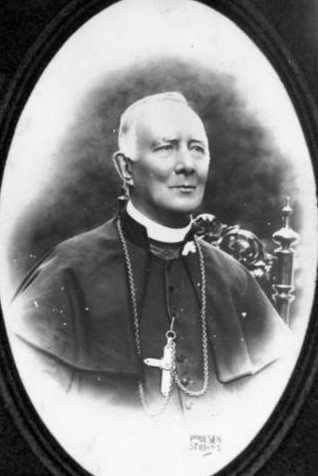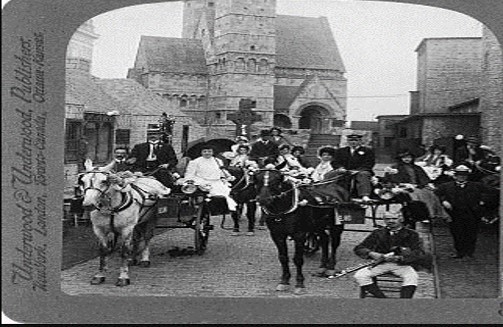In the late nineteenth century, leisure and culture were used by the Irish in Australia to assert their Irishness and aid their assimilation. The Catholic Irish clergy were particularly prominent in this regard. Alongside their laity, they used pageantry to promulgate a distinct and assimilatory Australian Irish identity in the Australian colonies. The ‘Irish Fancy Fair’ in 1885 Sydney, the capital of the New South Wales colony and the area of the first convict ship landing in 1788, demonstrates this identity creation. This particular fair was organised to raise funds for the Benedictine church and convent in Sydney. On a broader scale, this event relates to the Irish Catholic immigrant experience in terms of nationalist and religious tensions, assimilation and the influence of Irish Catholicism on their lives in the colonies. Contemporary, popular newspaper coverage of the fair highlight the context and circumstances of this fair.
Despite the Irish character of the event, the advertisements for the fair did not overly allude to the Irish amusements on offer there or its distinctly Irish character, besides labelling it as a ‘Grand Irish Fair’. One such advertisement in the Sydney Morning Herald, a conservative publication, illuminates this.[1] This advertisement focuses on the ‘great attractions’ and ‘vocalists’ available at the event. This omission of more Irishness may have been due to the brevity such advertisements require. However, it does include an Anglicised Irish phrase meaning a hundred thousand welcomes; ‘Cead mille failthe’. This use of the Irish language is interesting as the general reception of the Irish language in the Australian colonies was quite low.[2] Its inclusion may be explained by the concurrency of the Gaelic revival in Ireland, though this revival was generally ignored by Irish Australians.[3]
Irish Australian sentiment for Ireland
This event seems to have been solely covered by newspapers including the Freeman’s Journal, the Evening News and the Sydney Morning Herald. Of these, the Freeman’s Journal printed the most coverage of this event with four articles. The significance of this lies in the orientation of the publication. This paper was founded and supported by members of the Catholic Irish clergy and related to the newspaper of the same name in Dublin. Therefore, its coverage of the event may not have been as objective as that of other papers. It’s superfluous descriptions including adjectives such as ‘gorgeousness’, ‘unrivalled grandeur’ and ‘romantic splendour’ of the fair highlight this editorialisation.[4] However, the speeches included in the Freeman’s Journal coverage particularly illuminate the sentiment of the Irish-Australian community towards Ireland at the end of the nineteenth century.[5] Details of these orations are absent from their competitor’s coverage.
Firstly, a speech was made on behalf of the Irish Catholic community at the fair. In this, the speaker was keen to address the place of the Irish and their identity in contemporary Australia. He declared that there was ‘some reproach’ against the Irish in Australia that:
we are unwilling to forget the far-distant isle that has been our home or that of our fathers
This suggests that a sort of discrimination had pervaded the Irish community in Sydney’s immigrant experience. Contextually, the 1880s in Australia had been a time in which the Irish had borne the brunt of a renewed anti-Irish and anti-Catholic rhetoric.[6] Although, in comparison to the experiences of the Irish diasporas in Britain and America, Australia was seen as a friendlier environment to Irish Catholics.[7] The speaker also mentioned that a patriotic regard for Australia and Ireland were not mutually exclusive. This was a general sentiment of Irish Catholics who had emigrated to Australia. While these Irish emigrants desired to be accepted into Australia, a place they viewed to be a good society, they wanted their Irishness to be accepted too. Therefore, though they were ‘unique in their ordinariness’ as per the historian David Fitzpatrick, their maintenance of a distinctly Irish strand in their Australian identity was also unique.
A second speech printed in this article, given by Archbishop Moran, also demonstrated this nationalist identity and assimilatory struggle of Irish Australian Catholics.[8]

Archbishop, afterwards Cardinal, Francis Patrick Moran, 1900. Source: Trove.
He began by stating that he did not believe the fair would be put at any disadvantage due to its Irish character. He then stated that some may ‘blame’ the fair’s organisers for classing it as an Irish fair. However, with this, he believed that the ‘old country’, Ireland, could not be forgotten. He likened such a request of abandoning Ireland to be contrary to human nature. Ultimately, he stressed that the ‘Irish heart continues to beat with love for its native land’. Thus, the Irish Catholic Church in Australia wanted the Irish in Australia to preserve some semblance of Irish in their Australian identities, despite the negative reception which may accompany such Irishness. Finally, Moran called the Gaelic figures such as Brian Boru, which were on display at the fair, the ‘greatest, fairest and brightest’ in Ireland’s history. This connects with the assertion of the historian Patrick O’ Farrell that the Irish wished to establish an identity based on the Ireland of bygone days to enhance its respectability and nobility in the eyes of the other inhabitants of Australia.[9] However, it contradicts historian Donald Akenson’s stance that the Irish in Australia became ‘good ordinary Australians’.[10] Instead, the Catholic Irish and Catholic Church in Australia wanted the Irish community there to become good, ordinary Irish Australians.
A particular sort of Irish identity
The newspaper coverage of the event in the Evening News, noted as a less serious newspaper, refers to this specific historical type of Gaelic and Catholic Irishness promulgated at the fair by the Catholic Church.[11] Other articles in the South Australian Register, the Goulburn Herald and The Argus also attest to this Irish character, in a more condensed manner.[12] The Ireland on display at the fair was a historical one, centred on Catholicity and of Ireland’s nobility and respectability both in Gaelic times and at the beginning of the nineteenth century. Like most Irish Catholic cultural expression in Australia, it did not focus on the contemporary, potentially divisive climate in Ireland. Instead, characters such as Brian Boru, Erin, Hibernia and the Kings and Queens of each Irish province were featured. Irish jaunting cars, seanchaí and women representing each county of Ireland were also present. Unfortunately, there are no images of this particular fair. However, the black and white stereograph below of an Irish village at the World’s Fair in America in 1904 period may be demonstrative of some scenes described at this fair.

Stereograph of the Irish village at the World’s Fair is St. Louis, USA, 1904. Source: Library of Congress
Alongside this, a large portion of the costumed figures at this fair also had an important connection with the Catholic religion in Ireland’s history, suggesting another tenet to this Australian Irish identity. These figures included Daniel O’ Connell, Robert Emmet, Patrick Sarsfield and Owen Roe O’ Neill. Notably, O’ Connell, Sarsfield and Owen Roe O’ Neill were Catholics. Again, such an Irish identity aided assimilation in Australian society. It fostered an idea of Irish respectability which counteracted Australian perceptions of the Irish in Australia as cowardly and disloyal, due to their involvement in events like the Castle Hill Rebellion.[13]
The omission of certain figures from this event also supports the Church’s promulgation of an assimilatory boosting Irish identity. Though this fair took place in the 1880s, there was no inclusion of Charles Stewart Parnell (1846-1891) and no mention of the Home Rule movement which he was fronting at the time of this fair. This is interesting considering the postulation by historian Malcolm Campbell that, in the 1880s, the Irish in Australia had become much more nationalist due to this Irish Home Rule campaign.[14] Such a nationalist expression would have been contrary to the overall Irish desire for assimilation and progression in Australia.[15] This may be such characters were excluded from this event.
However, against historian Patrick O’Farrell’s thesis that the Irish in Australia solely wanted to foster a respectable image of Irishness, unrespectable and stereotypical Irish characters were also included. Such ‘funniosities’ and ‘comicalities’ were most likely featured to poke fun at these stereotypes.[16] For example, a figure depicting Samuel Lover’s Handy Andy, the moronic Irishman, was present. Biddy Moriarty, the foul-mouthed woman who appeared in folklore associated with Daniel O’ Connell, amongst others also played a part.[17] This may indicate that the Irish Catholic Church in Australia were not privy to such stereotypical perceptions of the Irish embedded into Australian popular culture. Though such characters may have been technically counter-assimilatory, they were not always excluded.
Additionally, coverage in the Freeman’s Journal highlights the use of music at the fair to create a feeling of respectable sentiment for Ireland itself, rather a radical nationalist spirit.[18] Songs of national Irish sentiment such as ‘Come Back To Erin’, ‘The Dear Little Shamrock’ and ‘The Harp That Once Through Tara’s Halls’ were used. The latter ballad was written by Thomas Moore, the Irish Catholic, whose songs were widely utilised by the Irish Australians with this same goal. However, all of these songs foster Irish respectability alongside a non-political regard for Ireland. They depict an idyllic Ireland, invoking a sense of nationalism linked to the country itself rather than its political divisiveness. Again, these songs emphasise a particular type of Irish identity which promotes a sentimental regard for the country of Ireland, devoid of radical nationalism.
‘good, ordinary Australians’?
The Irish Catholic Church influenced the identity of their laity in pre-federation Australia through pageantry. This fair was not just an Irish fair but a distinctively Catholic Irish fair. The characters, emblems and songs chosen were not haphazard decisions but careful considerations as to their assimilatory or anti-assimilatory qualities for Irish Catholics in Australia. Such considered, this Irish fancy fair of 1885 shows that the Irish in Australia did not simply become ordinary Australians, as per the historiography, but actively expressed their own unique hybrid identity there as Australian Irish. However, the newspaper articles utilised above were essentially advertisements for this event. This may have affected their tone and descriptions of this event.
REFERENCES:
[1] Michael Young, Death, sex & money (Carlton, 2007), p. 171; ‘Advertising’, Sydney Morning Herald, 20 Dec. 1884, National Library of Australia’s Trove (http://trove.nla.gov.au/newspaper/article/13575960?searchTerm=st%20benedict%20irish%20fancy%20fair&searchLimits=l-decade=188|||l-year=1884#) (25 Mar. 2017).
[2] Patrick O’Farrell, The Irish in Australia (Notre Dame, 2001), p. 178.
[3] Ibid.
[4] ‘The Irish fancy fair’, Freeman’s Journal, 3 Jan. 1885, National Library of Australia’s Trove (http://trove.nla.gov.au/newspaper/article/115465395/12708158) (25 Mar. 2017).
[5] Ibid.
[6] David Fitzpatrick, ‘The Irish character of the Australian Church’ in James Jupp (ed.), The Australian People (Cambridge, 2001), p. 456.
[7] O’ Farrell, Irish in Australia, p. 67.
[8] ‘The Irish fancy fair’, Freeman’s Journal, 3 Jan. 1885, National Library of Australia’s Trove (http://trove.nla.gov.au/newspaper/article/115465395/12708158) (25 Mar. 2017).
[9] O’Farrell, Irish in Australia, p. 220.
[10] Donald H Akenson, The Irish diaspora (Toronto, 1993), p. 108.
[11] ‘St. Benedict’s Fancy Fair’, Evening News, 2 Jan. 1885, p. 2 National Library of Australia’s Trove (http://trove.nla.gov.au/newspaper/article/111172701?searchTerm=irish%20fancy%20fair&searchLimits=l-decade=188) (25 Mar. 2017)
[12] ‘New South Wales’, South Australian Register, 29 Dec. 1884, National Library of Australia’s Trove (http://trove.nla.gov.au/newspaper/article/43809293?searchTerm=Irish%20fancy%20fair%20sydney&searchLimits=l-decade=188 ) (28 Mar. 2017); ‘Intercolonial telegrams’, The Argus, 29 Dec. 1884, (http://trove.nla.gov.au/newspaper/article/6063953?searchTerm=Irish%20fancy%20fair%20sydney&searchLimits=l-decade=188 ) (28 Mar. 2017); ‘Sydney’, Goulburn Herald, 1 Jan. 1885, (http://trove.nla.gov.au/newspaper/article/103281612?searchTerm=Irish%20fancy%20fair%20sydney&searchLimits=l-decade=188 ) (28 Mar. 2017).
[13] O’ Farrell, ‘The Irish in Australia and New Zealand, 1791-1870’, pp 662; 666.
[14] Campbell, Ireland’s new worlds, pp 140; 148.
[15] Malcolm Campbell, ‘Irish nationalism and immigrant assimilation: comparing the United States and Australia’ in Australasian Journal of American Studies, 2 (1996), p. 36.
[16] ‘St. Benedict’s Fancy Fair’, Evening News, 2 Jan. 1885, National Library of Australia’s Trove(http://trove.nla.gov.au/newspaper/article/111172701?searchTerm=irish%20fancy%20fair&searchLimits=l-decade=188) (25 Mar. 2017)
[17] ‘The Irish fancy fair’, Freeman’s Journal 27 Dec. 1884, National Library of Australia’s Trove (http://trove.nla.gov.au/newspaper/article/110065734?searchTerm=Irish%20fair&searchLimits=) (25 Mar. 2017).
[18] ‘The Irish fancy fair’, Freeman’s Journal, 3 Jan. 1885, National Library of Australia’s Trove (http://trove.nla.gov.au/newspaper/article/115465395/12708158) (25 Mar. 2017).